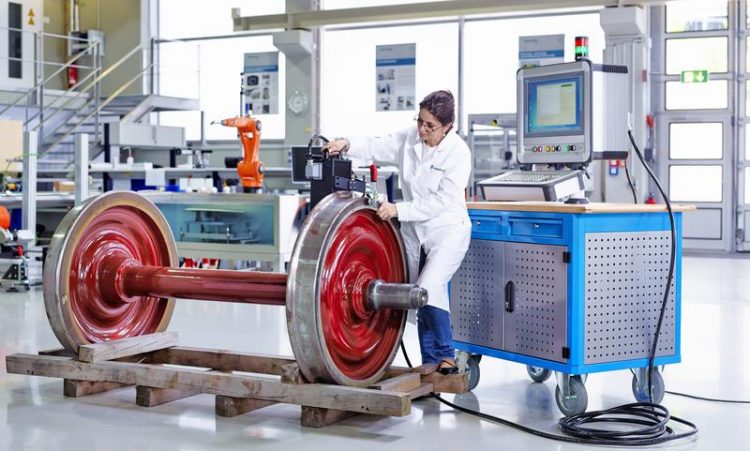Detecting residual stresses on freight train wheels

Determination of residual stresses in freight train wheels Uwe Bellhäuser
In the case of a car, the braking operation is carried out in seconds – jamming on the brakes and shortly afterwards the vehicle has stopped. But with a fully loaded freight train weighing lots of tons braking takes much longer – on long descents braking, which is required to prevent the train’s unwanted acceleration, can even take more than 30 minutes.
For the wheels and brakes this long braking time means hard work – such a strong mechanical loading and heating of the wheels may cause so-called tensile residual stresses, which can lead to cracks in the wheel tread and – worst case – to wheel breakage.
Geislinger Steige and Tauernbahn are best examples for routes that cause heavy endurance stress in wheels. Their strong inclinations and partly narrow radii require the permanent use of the wagons´ block brakes which generate the braking force by pressing the brake shoes against the tread of the wheels.
The scientists and engineers of the Fraunhofer Institute for Nondestructive Testing IZFP performed an elaborate redesign of the hard- and software of the so-called UER systems* by evaluating the experience gained with previous versions of the systems. Thus, they succeeded in adapting the new versions even better to the specific needs of the maintenance and wheel manufacturers plants.
While maintaining ease of use a variety of options for customer-specific documentation and report generation have been added. In particular, for the testing of newly manufactured wheels an optional software evaluation module is now available.
All UER systems, the new ones as well as all previously delivered systems, are integrated into the remote maintenance network of Fraunhofer IZFP, i.e. in case of a failure the service team is able to perform an extensive error analysis by remote access via Internet.
The inspection instruments are applied in the manufacturing process of new wheels, but especially in the maintenance of the freight train wheels.
Media Contact
All latest news from the category: Trade Fair News
Newest articles

NASA: Mystery of life’s handedness deepens
The mystery of why life uses molecules with specific orientations has deepened with a NASA-funded discovery that RNA — a key molecule thought to have potentially held the instructions for…

What are the effects of historic lithium mining on water quality?
Study reveals low levels of common contaminants but high levels of other elements in waters associated with an abandoned lithium mine. Lithium ore and mining waste from a historic lithium…

Quantum-inspired design boosts efficiency of heat-to-electricity conversion
Rice engineers take unconventional route to improving thermophotovoltaic systems. Researchers at Rice University have found a new way to improve a key element of thermophotovoltaic (TPV) systems, which convert heat…



